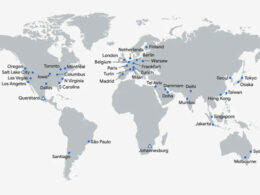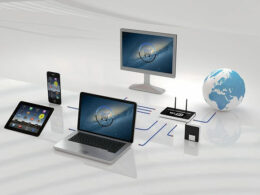Automotive IoT: Internet of Things and Connectivity in Modern Vehicles

Commuting has become an integral part of our lives. Fortunately, now, we can enjoy the full spectrum of amenities built into modern cars that make the driving experience safer and more comfortable. But how does a car define that an approaching vehicle is driving at an unsafe speed? By large, this is a merit of the Internet of Things (IoT) and connectivity to make vehicles as smart as we know them today.
This article gives brief insights on what Automotive IoT stands for, what are the benefits of adopting this technology in the automotive sector, how IoT solutions power up modern vehicles, and how IoT transforms the automotive industry. Besides, you’ll also learn about critical challenges related to connected cars and the software they run. Follow this link https://lembergsolutions.com/automotive to learn more details about automotive software development services.
What Is Automotive IoT?
Automotive IoT refers to using IoT technology to make modern cars faster, safer, and more comfortable. It’s a complex system of devices like sensors, cameras, and GPS trackers integrated into a vehicle to function as a unique structure for:
- better driving experience;
- predictive car maintenance;
- fleet management;
- connection of cars;
- driver’s safety and security;
- powerful infotainment system.
The IoT devices in cars are internet-connected and transmit data in real time. This allows vehicles to connect with external systems like traffic management software, communicate with a driver to improve the general driving experience, and interact with other cars to enhance safety on the road.
Apart from that, the use of IoT in the automotive industry laid the ground for leading solutions like ADAS and V2X, which help a driver maintain a safe following distance and benefit from the communication of a car with the surroundings.
Benefits of IoT In the Automotive Industry
The adoption of IoT in the automotive industry benefits all parties: vehicle manufacturers, drivers, and logistics business owners. This technology helps to make modern living more comfortable and far more efficient. For example:
- the IoT technology makes car maintenance a real pleasure. An intelligent system integrated into a car’s electronic control unit (ECU) scans different parameters to notify a driver about a potential issue before it happens.
- with IoT, car safety is not a matter of chance anymore. Since the reason for most accidents is human error, a IoT smart system analyzes the behavior of a driver in real time and recommends measures to avoid mistakes. It can be either a warning to put both hands on the steering wheel, insisting on keeping the lane, or a reminder to watch the road.
- the adoption of IoT for automotive makes the lives of those in logistics easier. It helps delivery companies keep track of vehicle’s tech conditions, predict malfunctions, calculate the optimal path, and monitor a driver’s behavior. As a result, shipping companies can provide better service, lowering maintenance costs.
How Will IoT Solutions Power Up Modern Vehicles?
The future of the Internet of Things for automotive is inspiring, and the way car manufacturers use this technology in modern vehicles is no less impressive. IoT technology is at the core of most car functions we enjoy daily. For example:
- improved safety. IoT allows car producers to experiment with connected vehicles. An integrated Dedicated Short-Range Communication (DSRC) sensor grants communication between cars. They share data such as speed, location, and direction to notify a driver if the risk of an accident occurs.
- predictive maintenance. The use of IoT in vehicles allows drivers to take better care of their cars as well as save on maintenance costs. A car notifies about malfunctions, helping to prevent breakdowns.
- energy efficiency. The Internet of Things for automotive comes in handy for electric vehicles, helping them optimize the charging process by adjusting power usage.
- autonomous driving. Self-driving cars were considered a miracle not so long ago, and now car manufacturers leverage IoT technology to make them work even better than conventional means of transport through autonomous driving.
How IoT Is Transforming the Automotive Industry
Modern driving looks nothing like it was before. It’s faster, safer, and far more comfortable. The rapid progress of automotive industry development is largely driven by the adoption of IoT. Let’s take a closer look at how this technology is transforming mechanical engineering.
Autonomous Vehicles
Leading automotive companies believe that autonomous driving is the future; thus, they experiment with IoT to introduce fully automated cars to the market. Although such vehicles are still under development, some autonomy is already available in modern cars. For example, drivers can benefit from:
- adaptive cruise control;
- lane-keeping assistance;
- parking assistance;
- blind spot management.
Predictive Maintenance
A smart maintenance system integrated into a vehicle allows drivers to relieve the headache of constant checkups. It monitors the parameters in real time and notifies a driver as soon as the service is needed. For example, you don’t have to guess when it’s time to change fluids, which saves on car maintenance costs.
Driver Monitoring System
An accident is a matter of seconds, as a driver can be easily distracted. The adoption of IoT in vehicles helps monitor a driver’s behavior, which results in better safety. For example:
- cameras monitor eye movements and facial expressions, helping to define the driver’s attentiveness level;
- sensors built-in car seats define how comfortable a driver feels, and a car can recommend to adjust a seat position according to ergonomic recommendations;
- a car also adjusts climate control and multimedia to relieve a driver’s anxiety. This is possible due to the synchronization of a fitness tracker that measures a driver’s heart rate with in-vehicle sensors.
Road Condition Analysis and Navigation Assistance
Thanks to GPS trackers, a car can calculate the fastest way to the destination point. The navigation system analyzes data received in real time to show the best route. It takes into account road conditions, traffic jams, and lane closures. All this results in reduced fuel consumption and a better driving experience.
Critical Challenges Related to Connected Cars
Although connected cars enhance the overall driving experience, vehicle manufacturers face certain challenges when releasing such vehicles to the market.
- Connected cars rely on GPS accuracy to power navigation features. If an IoT sensor fails to pick up accurate data, the use of integrated navigation software is not an option.
- The cost of implementing IoT technologies is high, and only leaders in car manufacturing can afford it.
- Cybersecurity risks are also a matter for connected cars, as when vehicles are packed with data, they are more prone to hacking attacks.
While the production of connected cars poses certain challenges to vehicle manufacturers, they experiment with new approaches to implementing IoT technology, thus contributing to the development of the automotive industry.
- Explore Knowledge: Community Q&A Apps Like Quora - May 17, 2024
- Verifying Digital Ads Using Residential Proxies to Avoid Fraud - May 17, 2024
- How AI Can Help Users With Multi-Tasking - May 17, 2024








